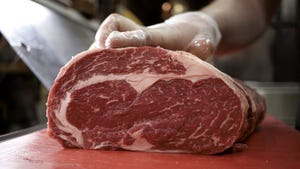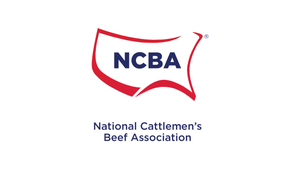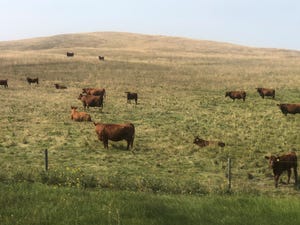Rush Creek Ranch maximizes gain per acre through designed, meticulous grazing management.
December 9, 2020
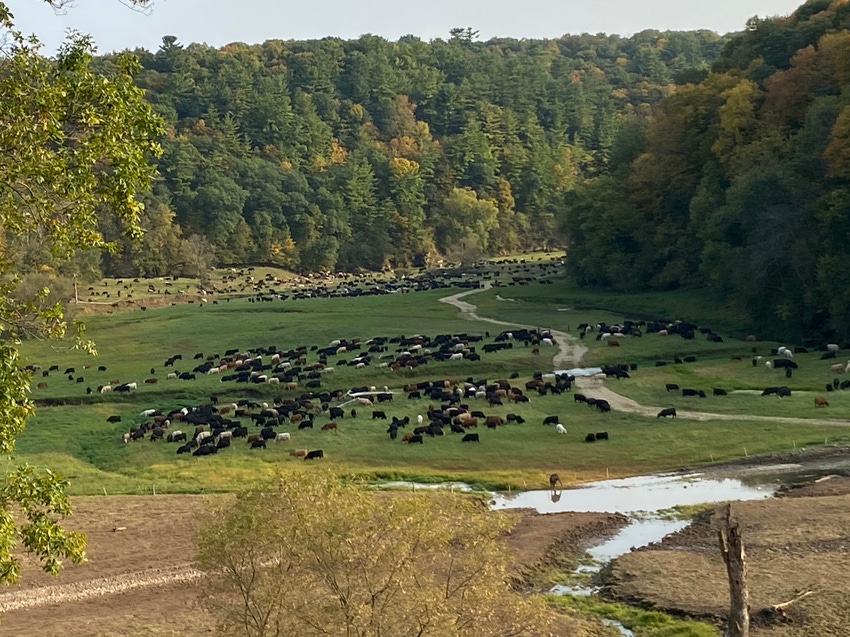
“I’ve always been really production oriented, that’s just my nature. Once we own an animal, we try to get as much weight on them as we can,” says Reid Ludlow. He and his son, Matt, own and manage Rush Creek Ranch near Viroqua, Wisc., this year’s National Stocker Award winner.
The Ludlow’s belief in spreading costs across more pounds is what led Reid to begin buying flyweight calves in the Southeast decades ago. It’s also why he embraced intensive rotational grazing from the outset, gunning to maximize pounds per acre.
We’ll get to all of that in a moment.
First, it’s important to understand that Reid chose to be in the cattle grazing business before he graduated from high school. It was his dream, but one analyzed with lots of deliberate, critical thought.
Reid spent his first years in Colorado, where his dad owned several small feedlots along the Front Range, and who also always ran cattle on grass, including at ranches he owned.
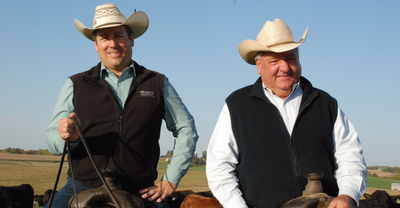 “The cattle on grass were always more interesting to me, and as I matured and got a better understanding of how the industry worked, I felt like there wasn’t as much competition in the stocker business as there was in cattle feeding,” Reid says. “I also liked the fact that you had more than a two-week window to market your cattle. I didn’t realize then how big of a deal that is.”
“The cattle on grass were always more interesting to me, and as I matured and got a better understanding of how the industry worked, I felt like there wasn’t as much competition in the stocker business as there was in cattle feeding,” Reid says. “I also liked the fact that you had more than a two-week window to market your cattle. I didn’t realize then how big of a deal that is.”
It’s obvious that Reid and his folks were close and that he spent lots of time shadowing his father.
His dad died just before Reid turned 13. Ultimately, his Mom sold the feedlots and the ranch. She married a Chicago lawyer; Reid went to high school in the Chicago suburbs.
“So, I had a broader view than I would have had just staying in Colorado,” he says. But, his dream was to run a grazing program or a ranch and there was no longer an ongoing operation at home.
Reid attended Colorado State University, where he got a degree in business. Throughout his college years, he kept thinking about his dream. He also spent time looking around the U.S. and working for different cattle operations, including in Montana, southeastern Colorado and at the U.S. Meat Animal Research Center in Nebraska.
“I would ask questions of all of those people I worked for. I formulated more ideas about what might work and might not work, what some advantages were and disadvantages.
He created a short criteria list for his operation. The ground had to be deeded acres. The operation had to be located in an area where there was sufficient rainfall or there was the ability to irrigate. Finally, it had to be in a strong market for feeder cattle.
That led him to southwestern Wisconsin, where his dad once owned property.
“This ground was basically the same price as a lot of the western ranchland, but many, many times more productive; in essence it was cheaper,” Reid says.
In 1976, when Reid began the operation, this part of the state consisted mostly of small dairies.
“What we really competed on was a place that didn’t have a dairy setup. It didn’t have many building on it and it didn’t lay so well that a cash grain farmer would buy it. But, we also tried to buy ground that didn’t have many woods. We cleared any of the woods that were there, if it wasn’t too steep.”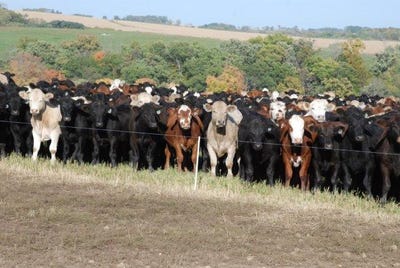
Rush Creek, the skinny version
Here’s the thumbnail sketch of Rush Creek Ranch today. Via order buyers, the Ludlows buy flyweight calves (180-280 pounds or so) in the Southeast from various sale barns, one at time, during the fall and winter.
These high-risk calves go to conditioning yards in the Southeast where they’re straightened out and readied to graze ryegrass, primarily in Alabama, Florida and Georgia.
All of that is accomplished with a trusted network Reid cultivated over the years, spending lots of time in the Deep South.
So, there’s a bit of geographic arbitrage, taking cattle from a part of the country that values the cattle less to one that values them more.
When there’s enough grass growth, usually around the first part of May, all of those calve are shipped north to Wisconsin over about a week’s time.
Here at Rush Creek, these cattle will graze through 32-40 five-acre pastures of perennials (brome grass, orchard grass and red clover), being rotated as often as twice a day earlier in the season (more in a minute).
From the middle of November to just before Christmas these cattle are shipped to feedlots in the west. Depending on the market, the cattle are sold to buyers or Rush Creek Ranch retains ownership through the finishing stage.
Another level of rotational grazing
When Reid started out, he says many already recognized they could increase stocking rates through rotational grazing.
“When we first came here it was a four or five pasture rotation. By the next year I was working hard on getting that to be a 10 or 12 pasture rotation; one set of cattle rotating through 10-12 pastures,” Reid explains. “Even back then, we were stocked twice as heavy as we would have been if we weren’t rotational grazing. We were stocked at about two head per open (non-wooded) acre for the summer on our ground being rotated; about one per open acre on leased ground, which was set stocked.”
These were primarily 40-acre pastures until 1988 when Wisconsin faced severe drought. That’s when they carved them into 10-acre pastures. That was still the setup when Matt returned to the operation in 2008. Before then, Matt obtained degrees in economics and finance and worked in the financial world.
Then came the decision to divide the pastures into smaller five-acre paddocks, which meant more frequent rotations.
Depending on the size of cattle, a herd of 650-900 head will rotate through the 32-40 pastures. Think of these as a single unit. Another herd makes its way through a different 32-40 pastures (unit) and so on. All told, Rush Creek runs eight different herds through the system each year.
“We sit down and try to figure out how many cattle, how much weight we want on a particular unit, and we try to maximize total gain. We put enough cattle out there to keep up with the spring growth,” Reid says.
Reid and Matt move cattle twice each day in the spring and then less frequently through the height of growing season to the point cattle are rotated through pastures every two to three days in the fall of the year. This is all done via horseback. You’ll find a trailer perpetually hitched to their pickups. These are the type of folks who take their boots off, but leave the spurs strapped to them.
“Our stocking rate has increased about 5% per year,” says Reid. “One of the main advantages when we went from an 8-12 pasture rotation up to 32-40 pastures is manure distribution. The distribution is so much better when you have really heavy stocking density. We operate in an area where the soil and moisture are good enough that the fertility is able to come up.”
For perspective, Matt explains the same ground comprised of 10-acre pastures that supported about 1,050 head now supports about 1,400 in five-acre pastures.
Every herd has its own feed bunks on skids that are chained together, which move with the cattle each and every time. These bunks are positioned opposite of the water source in each pasture, trying to ensure the most even manure distribution throughout the entire pasture. So, the pastures get coated with manure, but you’d be hard-pressed to find any once the cattle return for the next trip.
“It makes a big difference over time. I don’t think we have a complete understanding of all that is going on in the soils, all of the organic activity, etc. This system is really environmentally sound,” Reid says. He also notes they’re utilizing more of what’s growing in each pasture than when cattle were less densely stocked.
Bottom line, Matt points out being able to run more cattle without having to invest capital in purchasing more acres is a tremendous advantage.
“We’re not trying to get the most absolute gain out of the cattle,” Reid says. “We’re giving up quite a bit by rotating as intensively as we are. There’s no doubt that we’re giving up some because you’re taking away all of their selection ability. We’re giving up individual weight gain to get more gain on that acre.”
With that said, Matt explains, “If you look at the total pounds we can gain here in Wisconsin in a given season, it always surprises me. We used to put 300 to 350 pounds on them in the summer and now we’re gaining between 400 and 475 pounds.”
Leveraging forage with feed
Part of that increased gain came with the decision several years ago to utilize supplemental feeding as a way to stockpile and extend forage, while maintaining cattle numbers and performance.
“When we finally decided to feed, that was a hard decision because we were supposed to be a simple summer grazing operation that didn’t have a lot of overhead. When you start to feed, you change a lot of things,” Reid says. “You’ve got equipment, bunks, more help. But, we felt like we would always be in an area where we could buy feed less expensively than a lot of our competitors because we’re in the upper Midwest. Of course, that doesn’t mean you can’t buy it wrong.”
The bounty of feedstuffs in the area includes byproducts such as dried distillers grains, malt sprouts and barley screenings from breweries, soybean hulls and the like.
Although every byproduct comes with its own nutritional baggage, Matt says, “In our opinion, if we can take a handful of these byproducts and combine them with something decent like corn silage, along with the grass, we can put together a total ration that works.”
Spun differently, their ration is based on digestible fiber with a protein source.
When it comes to supplementing cattle on grass, Reid believes, “You’ve got to feed something where you’re not hurting the digestion of the forage, and that can be fairly difficult, in our opinion. So, we feed digestible fiber. We’re holding it all together in the bunk with corn silage; the rest of it is byproducts.”
“When you take all of the expense we have wrapped up in these animals, we feel like if we can convert the supplemental feed well enough, while still utilizing the grass, we can make a return on the purchased feed,” Matt says.
They feed and grade
Coast through Rush Creek pastures at the beginning of October and you’ll be struck by how lush the pastures look, how un-crowded they appear, even with such a high stocking density and the 12 O’clock condition of the cattle. Thinking back to all of these cattle being bought mostly as singles, never minding color, you’ll also wonder how such uniformity is possible.
Fact is, these cattle don’t just look the part.
“We’ve gridded our cattle coming out of the feedlot the last handful of years and they have averaged 90% plus for Choice or better, which is pretty astonishing when you think about buying a 180-200-pound calf and putting it on grass for that long,” Matt explains. “Our nutritionist told us if you put them on a relatively high, good plane of nutrition for an extended period of time, the better the grading analytics will be.”
Matt, who also serves as president of the Wisconsin Cattlemen’s Association, believes part of the improved feeding and carcass performance in their cattle stems from what he views as a sea change in the overall quality of cattle, especially since the massive cowherd liquidation during the widespread drought a few years ago.
“Most stocker operations I know of sell cattle when they get to a certain weight, or weight range. Our cattle, no matter what they weigh coming to Wisconsin, we’re shipping them all at about the same time, usually from just before Thanksgiving to just before Christmas,” Reid says.
“The other reason we’re doing that is we’re trying to have those cattle hit the April board (Live Cattle futures). So, if they can be done from the middle of March to the first of May, that’s the goal,” Matt explains. He notes that historically there’s a hole in fed cattle supplies as average yearlings finish, before calf-feds start to make their way to rail, and as spring consumer demand begins to pick up.
Relationships are key
“Our deal wouldn’t work without all of these relationships,” Reid says. The relationships include the buyers, conditioning yards and grazers in the Southeast.
“We’ve used some of the same people for 40 years and more in the South. Those buyers will come to Wisconsin to look at the cattle as yearlings so we can talk about how we need to adjust for the next year’s buy.”
Of course, the relationships also include all of those within the Rush Creek operation.
“We’ve been fortunate to find really good people who help us before the calves get to Wisconsin,” Matt says. “And, we have great people who work for us fulltime. We’re really lucky in that regard.”
You May Also Like
